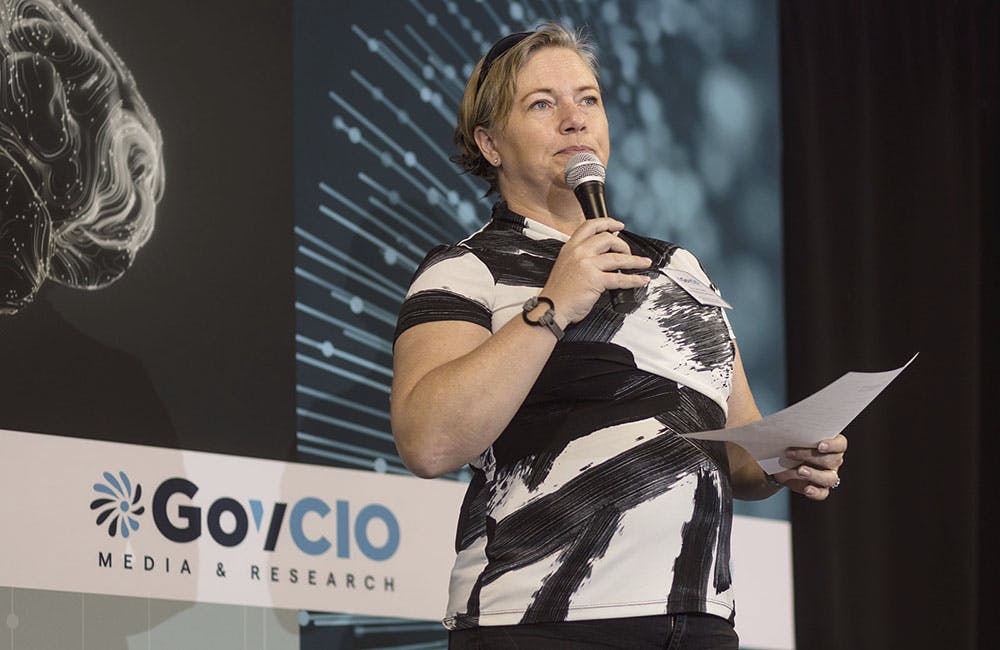Marine Corps Launches First Software Factory, Taking Notes from Ukraine
Future Marines need to know how to shoot, move, communicate and code, according to software leaders at the Marine Corps.

The Russia-Ukraine war informed the vision of the first U.S. Marines Corps Software Factory launched last week, the factory’s director told GovCIO Media & Research in a new interview.
Future warfare will be “highly lethal, contest, disconnected and pretty ambiguous,” Marine Corps Software Factory Director Lt. Col. Charlie Bahk said, highlighting the need for Marines who can solve problems quickly on the battlefield.
This is where software solutions come into play.
“It’s all about pulling your decision-making cycle as much as possible,” Bahk said. “You want to be faster than the other guy. You want to ingest conditioned and curated data and information from all your sensor networks out on the battlefield; you need to be able to ingest and make sense of that and act on it faster than your adversary. We’re seeing this in the Russia-Ukraine conflict right now, where they have conscripted up to 300,000 software developers to gain the tactical advantage and it’s a little bit of the same mindset. It gives us that ability to utilize organic, active duty and reserve component Marines who have the operational experience that have been serving down at these tactical level units, you know, breathing the same air and chewing the same dirt with these commanders, and truly, intimately understanding these problems and working on solving those problems.”
Software to Meet Mission Needs
The latest software factory within the Defense Department ecosystem highlights an accelerating cultural shift to transform military service members into software developers and engineers who can rapidly prototype new solutions anytime, anywhere to meet mission needs at the speed of relevancy.
The department’s software modernization strategy, released in early 2022, vaulted software factories to the forefront of DOD software innovation and asked all of DOD to follow their lead.
Software factories within the Department of the Air Force, Army and Navy have already impacted defense tech modernization in significant ways.
Air Force CIO Lauren Knausenberger and CTO Jay Bonci credited software factories with helping pave the way to zero trust implementation at the Air Force in recent interviews with GovCIO Media & Research, while Air Force BESPIN Software Factory and Navy Black Pearl Software Factory described how their emphasis on DevSecOps is critical to actualizing DOD’s Joint All-Domain Command-and-Control (JADC2) initiative during a virtual event with GovCIO Media & Research last year.
“To get that speed to warfighter, we have to have that cloud everywhere in the world and have that software on demand,” Knausenberger said at the Air Force Summit last year.
Before the official launch of the Marine Corps’ first software factory, Bahk was leading rapid software development solutions to meet critical mission needs. Last year, the 2nd Marine Division called Bahk asking for a software solution maximizing maritime commercial radar capabilities.
“We scoped the problem to design the solution, built it and then delivered it all within 90 days,” Bahk said. “And then, all the intelligence units across all [Marine Expeditionary Forces] started to use this application, and it gained widespread adoption to where the acquisition community is starting to talk about how to or whether it should be rolled up into an enterprise level solution.”
Bahk wants to replicate this success story through the new software factory. Marines are known for being able to solve problems with limited resources, he said, so the next step is for every uniformed Marine to be able to solve a software problem.
“It’s all about outcomes for Marines, right? It’s all about increasing what’s [valuable] for the Marines at the tactical edge with solutions that are built by Marines, for Marines, and these Marines are there, they’re informed by their operational experience. That’s the secret sauce.”
The new Marine Corps Software Factory aims to align with Deputy Secretary of Defense Kathleen Hicks’ vision for IT modernization at DOD, Bahk added.
“We are a part of a broader ecosystem. She wanted a department-wide, modernized software development ecosystem,” he said. “And, you know, with all of the different software factories across all the different services within the DOD, we are all a part of that ecosystem. And they take it seriously. [We] keep each other informed on what the latest is because this is the new frontier.”
Supporting a Stronger Workforce
The new software factory also aims to address current workforce gaps at DOD, such as the cyber workforce, by upskilling Marines. The DOD OCIO recently released a cyber workforce strategy to address recruitment and retention challenges with DOD civilians and service members, highlighting competition with industry as a major challenge but also an opportunity to upskill and retrain civilians and service members to increase their value.
“We haven’t done a good job of that in the past,” said Patrick Johnson, who leads DOD’s Workforce Innovation Directorate, during a call with reporters March 9. “We’re not going to hire our way out of this. It’s time to grow our own, build our bench and bring on more entry level positions and train them.”
Marketing the mission is a big selling point for recruitment and retention according to DOD workforce leaders, including the Chief Digital and AI Officer, Dr. Craig Martell.
“This [software factory] provides an opportunity for our Marines to learn very tangible and valued skillsets alongside industry experts,” Bahk said. “They’re all doing this while they’re executing a mission that increases with value to the service and also makes them marketable to industry. What we’re seeing with the Army Software Factory is that if you give service members the opportunity to do meaningful work, you know, tied to a mission that matters, they’re more apt to staying in, and we’re seeing that empirically. Moving forward, we would love for the Marine Corps Software Factory to be an opportunity that’s available to any Marine because that diversity of operational experience is very important and enriches this solution development process for Marine problems at the tactical edge.”
According to a popular Marine tagline, every Marine should know how to shoot, move and communicate, Bahk said. But a good friend of Bahk’s, Lt. Col. Sam Gray, came up with a new motto to represent the future of the Marine Corps more accurately with the launch of the new software factory.
“In the future, Gray said every Marine should know how to shoot, move, communicate and code,” Bahk said.
Editor’s Note: This story was updated to clarify the rollout of Bahk’s software solutions across Marine Expeditionary Forces.
This is a carousel with manually rotating slides. Use Next and Previous buttons to navigate or jump to a slide with the slide dots
-

White House Science Chief: US-Driven AI Sets Global Standards
Michael Kratsios outlined how American AI technology on the global stage will help standardize the tech and counter China’s influence.
5m read -

Modernizing Critical Infrastructure in the Face of Global Threats
Officials are expanding the latest strategies in boosting defense infrastructure, including securing satellite communications, upgrading enterprise-wide technology, optimizing data management.
20m watch -

DOD Accelerates Software Modernization with Agile DevSecOps Push
The Pentagon's software implementation plan tackles cultural hurdles and integrates security early to deliver critical capabilities faster.
6m read -

VA's Platform One Powers Rapid Innovation to Bolster Digital Services
VA's Platform One accelerates software development timelines from weeks to hours, ultimately enhancing digital services for veterans.
5m read -

Doing More with Less is Muscle Memory for IRS, Former Deputy CIO Says
Darnita Trower discusses her experience, the legacy she’s left behind and how she pushed the IRS to modernize itself,
20m watch -

Opinion: Original Intelligence Is the Missing Piece for AI Transformation
Limitations of AI agents and development drive growing needs for workforce development and "original intelligence."
3m read -

VA CIO Targets Modern IT and Smarter Workforce Alignment
Agency leaders told lawmakers they are focused on trimming legacy systems and restructuring its workforce to streamline operations.
3m read -

Pentagon's $200M AI Contracts Signal Broader Effort to Transform Talent
The Army is leveraging Silicon Valley, reservist programs and new hiring strategies to integrate critical digital skills in its ranks.
5m read -

Inside DOD’s Push to Grow the Cyber Workforce Through Academia
Diba Hadi gives her first interview since becoming principal director of the DOD’s Cyber Academic Engagement Office.
15m listen -

Generative AI Demands Federal Workforce Readiness, Officials Say
NASA and DOI outline new generative AI use cases and stress that successful AI adoption depends on strong change management.
6m read -

The Next AI Wave Requires Stronger Cyber Defenses, Data Management
IT officials warn of new vulnerabilities posed by AI as agencies continue to leverage the tech to boost operational efficiency.
5m read -

Federal CIOs Push for ROI-Focused Modernization to Advance Mission Goals
CIOs focus on return on investment, data governance and application modernization to drive mission outcomes as agencies adopt new tech tools.
4m read
















